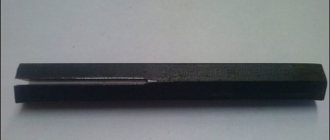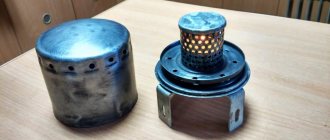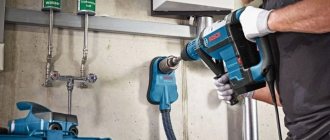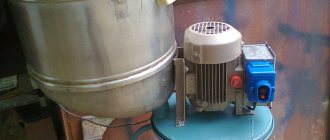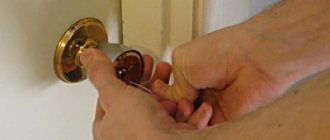I wrote “universal wrench” in the title and seriously doubted it. What kind of key is this when we are talking about a real all-powerful master key-opener-twist, which can be made in a couple of minutes from an old and unnecessary bicycle chain. Having such a homemade device, you no longer have to Google or Yandex something like “buy a universal wrench.” You will have a truly all-powerful tool at your fingertips if you pick up a rusty chain and decide to put in just a little effort.
So, let's go. First, we’ll tell you how this device is made, and then, using several examples, we’ll show how it can move mountains.
Purpose of the puller
According to the car's operating manual, problems with how to unscrew the oil filter yourself cannot arise in principle:
- When changing the oil, a new filter is installed;
- the sealing rubber must be lubricated with lithol;
- tighten the consumable element by hand;
- tighten 1/3 turn with slight force.
In this case, the rubber sealing ring does not stick to the ebb of the engine housing; the filter can be removed by hand without a puller. In case of severe contamination of the housing, use a piece of sandpaper - the hand does not slip, the abrasive material ensures reliable grip of the palm on the filter housing.
A piece of sandpaper for unscrewing the oil filter
These requirements are often violated by the users themselves:
- there is no lubrication of the rubber ring; at high pressure and temperature it loses elasticity and sticks to the filter housing and the engine seating surface;
- It is not clear for what purpose the car owner tightens the thread with both hands, tightening it and flattening the rubber seal.
Even in this case, you can try to do without a puller:
- tap the rim in a circle on the side of the sealing ring to ensure its mobility relative to the filter housing or the ebb of the groove of the seating surface;
- pierce the rubber seal with a narrow screwdriver, separating it from the low tide side.
Tapping the rim in a circle
In all other cases, you have to use special devices to twist this consumable item. Since access to the filter is difficult, and its outer size differs on different machines, the question of which puller is better, in principle, does not make sense for the following reasons:
- there are turnkey or head pullers with their own handles;
- some tools are made for a specific filter diameter;
- other pullers have adjustable gripping devices of several sizes;
- Universal sliding devices are suitable for any passenger car filters.
Purpose of the oil filter puller
To purchase or independently manufacture a specific puller model, you should familiarize yourself with the design of each of them.
Differences between a screwdriver and an impact driver
Many people mistakenly think that an impact driver is a good alternative for a screwdriver, but this is deeply misleading. Both devices differ significantly from each other not only in design properties, but also in their operating principle. The screwdriver transmits impact force in a plane perpendicular to the axis of rotation. By the way, this distinguishes it from an impact drill, which is capable of creating shock loads along the axis of rotation. True, a screwdriver only facilitates the process of unscrewing and tightening an already rotating screw.
The functionality of such devices is completely different:
- Impact screwdrivers perform the initial “breaking” of a screw that has become too “stuck” to the connection.
- An impact-type screwdriver reduces the required pressure on the tool when performing the task.
After studying all the features of the tool, be sure to watch the corresponding training videos that will allow you to decide on a specific model from a specific manufacturer. In this case, you will be able to make the right decision and purchase a truly useful and reliable tool that will serve you for a very long time.
Read also: Difficult to read numbers on the frame
Why might this be needed?
Easy and quick: how to make a cube out of paper
Car manufacturers recommend changing the engine oil every 15 thousand kilometers. Under difficult operating conditions, for example, when traveling with a trailer, the lubricant is changed more often. When changing the oil, it is advisable to change the oil filter.
Many car enthusiasts do not understand the reasons for replacing the oil filter when the lubricant is changed. The engine is the heart of the car; it is subject to the greatest wear and tear, since it bears the main load. The engine fluid being poured contains foreign particles that have a bad effect on the operation of the engine. An oil filter is designed to filter out these particles. The more it is worn, the worse the quality of the lubricant becomes, and this, in turn, affects engine wear.
Structure of the filter element
It is impossible to determine the suitability of an oil filter by appearance. It is also difficult to draw conclusions about the need for replacement based on mileage. The filter element works constantly, even when the engine is idling, so its wear depends not on mileage, but on engine hours. Some drivers, when changing the oil, neglect to replace the filter element, considering it unnecessary.
When choosing a replacement product, it is important to focus not on its appearance, but on its content. Drivers with an aggressive driving style are better off installing expensive products.
This is due to the fact that when driving fast, hard braking or accelerating, the engine requires a large amount of oil. Expensive filters have synthetic elements that can withstand loads and high temperatures well, allowing the oil to pass through quickly. Analogues have felt-based elements through which the lubricant passes longer than through synthetic material. These products are suitable for lovers of a quiet ride.
Method 3: Using a leather trouser belt
If you don't have an old timing belt at hand, a regular leather belt will do just fine.
- The principle is as follows: the belt is put on in a loop and tightened with force. In this case, the long end of the belt serves as a lever.
Do not forget that the oil filter is unscrewed counterclockwise.
The most important thing is that the filter housing is clean, otherwise the belt will slip. For better contact, the surface of the filter can be slightly sanded.
Method 4: Hammer + chisel.
- Everything is very simple here: a deep notch is made on the filter body on the thread side, then a chisel is inserted into it and the filter is torn off the thread with tangential hammer blows.
- Next, the filter element is unscrewed by hand. This method is rarely used, since the free space around the filter is limited and there is practically no room for such maneuvers.
Read also: Construction of a polyurethane foam cylinder valve
VIDEO INSTRUCTIONS » alt=»»>
What do you need to know about other pullers?
How to make a greenhouse from window frames with your own hands quickly and easily
The chain oil filter puller, depending on the design, allows you to unscrew and tighten filters with diameters ranging from 60–140 mm. It consists of a handle and a chain attached to it at one end, which serves as an adjustable grip. Most pullers are equipped with a single-row chain, but there are also models with a double-row chain. The second end of the grip, depending on the design, can be free or passed through a special groove located in the handle and having a lock.
During the first execution of the puller, before unscrewing the filter, the chain is tightly wound around its body, almost to the end. The remaining section of the grip is attached to the hook on the handle. After this, the puller rests on the filter and acts like a lever. The second version of the tool already has a loop made of chain, which has adjustable dimensions and is immediately thrown onto the filter. After this, pulling the end of the gripper passed through the groove, tighten the loop and press on the tool handle in the desired direction. At the same time, the groove lock securely holds the chain, preventing it from loosening its grip.
Grab with chain loop
Belt pullers have a working diameter range of 25–160 mm. They have a special belt that forms a loop to hold the filter. It can be fixed at both ends in a square steel rod. A belt is wound around it after the loop is thrown over the filter. Then a suitable key is placed on the rod and the cleaner is unscrewed. Another type of puller is similar in design and use to the second type of chain tool.
The operating range of belt filters is one of the narrowest - the difference between the minimum and maximum permissible filter diameters can reach only 30 mm. They use a strip of steel or plastic, fixed at both ends to the handle and forming a loop, the size of which can be slightly adjusted in some designs. After throwing the grip on, force is applied to the handle and it acts like a lever. The tightness of the filter coverage is achieved in some designs by a screw on the handle, and in others - due to natural tension when unscrewing. Most pullers of this type often fail to cope with filters that are too tight.
Belt filter part remover
The tools are sickle-shaped and pliers-shaped and have 2 working curved jaws with notches and 1 or 2 handles. Their working range of grip is also small; in some designs it is adjustable. Work with these pullers as with ordinary pliers - grab the filter, squeeze and unscrew.
A puller with 2 adjustable jaws consists of a thick narrow base plate, a screw and paws with notches on the working part. The threaded ends of the grippers are moved in the longitudinal slots of the base and secured in the desired position with a nut. When you tighten the screw passing along the thread of the hole in the center of the plate, after it is pressed tightly against the filter, the latter is unscrewed.
Types of industrially manufactured pullers
Depending on the design features and size of the filter, pullers of one type or another are used to unscrew it. Their body or base is usually made of steel and is protected with a matte or silver chrome finish. A number of products, if provided for by the design, have plastic linings on the handles, which greatly simplifies the work with such a tool.
Oil filter loosening tool
Almost all pullers allow you to unscrew both oil purifiers (hereinafter referred to as cleaners) and oil cups - filter casings with a replaceable insert. All pullers can first of all be divided into universal ones and those designed for unscrewing filters of only one diameter or type.
Among the first, the following main types are distinguished:
- crab;
- belt;
- chain;
- tape;
- sickle-shaped and tick-shaped;
- with 2 adjustable grips.
Puller with 2 adjustable jaws
Their versatility is relative - not every filter can be unscrewed with them. Firstly, because they are designed for a certain range of diameters of cleaners, and for some pullers it is quite wide, while for others it is not very wide, and secondly, because of their own design features and dimensions. After all, the location of the filter, as well as the accessibility of the filter, differs on different cars, and therefore it will be easy and simple to work with any tool in one engine compartment, but perhaps completely impossible in another.
Only one type of tool is classified as narrow-profile - cup oil filter pullers. They received this name for their appearance, reminiscent of the kitchen appliance of the same name.
Do-it-yourself universal key made from a chain and bolt
11 ways to remove old wallpaper from walls quickly and easily
Dear visitors to the Labuda Blog website, from the material presented you will learn how to make a universal key yourself from a bicycle chain, a bolt and three nuts with your own hands. Step-by-step photos of assembling the wrench are presented and so off we go... Many of you have probably encountered such a problem... when the edges on a nut or bolt being turned off are a little knocked off and a regular wrench simply turns without performing its function. This can be solved with the help of a homemade chain wrench that works in compression, that is, the stronger the handle of the key, the stronger the chain will be clamped and thereby unscrew even the most eaten nut or bolt. To make a universal key you will need a piece of a bicycle chain, two nuts and bolt. We screw the nuts onto the bolt and weld a piece of chain to them so that we get a grip and weld it to the other side of the nuts. Next, we put the chain on the nut or bolt that needs to be unscrewed and tighten the bolt, thereby tensioning the chain, everything can be unscrewed) Materials bicycle chain nut 2 pcs bolt Tools welding inverter angle grinder (grinder) Step-by-step instructions for assembling a universal wrench with your own hands. And so, the necessary parts to assemble the key. Two nuts are screwed onto the bolt. We measure the chain, namely how much is needed from nut to nut. We make a mark in the place where the chain should be riveted. We clamp the chain in a vice and cut off the rivets using a grinder. We knock out the rivets. Next, the chain is welded first to one nut. Then it is tensioned and welded on the other side of the nut. Scale and excess metal are removed using an angle grinder (grinder). Then unscrew the bolt and loosen the chain to the required diameter. Insert the nut and tighten the bolt along the threads, thereby...
Dear visitors to the Labuda Blog website, from the material presented you will learn how to make a universal key yourself from a bicycle chain, a bolt and three nuts with your own hands. Step-by-step photos of assembling the key are presented and off we go..
Many of you have probably encountered such a problem... when the edges on a nut or bolt being turned off are a little knocked off and a regular wrench simply turns without performing its function. This can be solved with the help of a homemade chain wrench that works in compression, that is, the stronger the handle of the key, the stronger the chain will be clamped and thereby unscrew even the most eaten nut or bolt.
To make a universal key you will need a piece of a bicycle chain, two nuts and a bolt. We screw the nuts onto the bolt and weld a piece of chain to them so that we get a grip and weld it to the other side of the nuts. Next, we put the chain on the nut or bolt that needs to be unscrewed and tighten the bolt, thereby tensioning the chain, everything can be unscrewed)
Materials
Tools
Step-by-step instructions for assembling a universal key with your own hands.
And so, the necessary parts to assemble the key.
Two nuts are screwed onto the bolt.
We measure the chain, namely how much is needed from nut to nut.
We make a mark in the place where the chain should be riveted.
We clamp the chain in a vice and cut off the rivets using a grinder.
Next, the chain is welded first to one nut.
Then it is tensioned and welded on the other side of the nut.
Scale and excess metal are removed using an angle grinder (grinder)
Then unscrew the bolt and loosen the chain to the required diameter.
We insert the nut and tighten the bolt along the threads, thereby tensioning the chain and clamping the resulting connection.
Let's test the key in action.
We consolidate the material covered by watching the video. Enjoy watching)
Materials for production
In order to make a universal key, you will need:
- profile pipe measuring 25x25 mm;
- motorcycle chain 50 cm long;
- welding machine;
- Bulgarian;
- various types of threaded connections for testing.
Step 1. Making a universal key
Cut a piece 30 cm long from the profile pipe.
We attach 4 chain links to one of the edges of the cut pipe.
We weld the chain securely on both sides.
We pass the second end of the chain through the profile pipe.
Step 2. Conduct a test
We put a lasso from a chain on a round pipe. Thanks to its shape, the chain securely grips the pipe over its entire surface, clamping it tightly.
Let's test the pressure of the wrench on the surface being treated on a wooden branch. This is the deep dent a regular pipe wrench leaves.
Our universal wrench is more gentle on the surface being unscrewed.
The wrench also fits a regular hex nut perfectly over the entire surface and does not turn.
And when working with plastic pipes, such a wrench is simply irreplaceable.
DIY universal key
DIY universal multifunctional wrench
Where can I use such a universal key?
This tool can be used in many jobs. If the length of the chain allows, it can be used to unscrew the oil filter in a car. And in general, it is convenient to use it in hard-to-reach places where it is not possible to work with a gas or adjustable wrench.
There is another option for manufacturing a similar tool, where only one side of the chain is welded to the nut. At the opposite end of the nut, a hook is welded to which the chain will cling. In this case, a longer chain is used here. This allows you to adjust the diameter of the circle depending on need.
But even the simplest version of a universal tool, discussed today, allows you to perform various jobs that are inaccessible to a regular key. And you can start checking the functionality of the device from the same bicycle frame from which the chain was removed. For example, you can try to unscrew the pedal carriage nut.
PHOTO: YouTube.com The key fits perfectly under the nut, while clamping it as tightly as possible
Interestingly, we even managed to tighten the carriage nut a little, despite the fact that the bike had been lying in a damp attic for a long time.
Another advantage of the key
Sometimes it is impossible to unscrew plastic parts, for example, when replacing a water filter element. It is clear that the gas wrench is clearly not an assistant here - the pressure will simply crush the plastic. But with our device this can be done due to the uniform distribution of pressure along the entire circumference of the plastic cover.
In general, such a tool is very convenient to use. At the same time, you can use it to unscrew even small nuts. But to unscrew larger, and especially stuck parts, the homemade wrench will have to be strengthened and made more powerful.
PHOTO: YouTube.com This universal tool makes it easy to unscrew even fragile plastic parts
Details about the universal “crab”
The “crab” puller consists of two plates, which are the body, and 3 grippers installed between them. There are notches on the working surface of the paws that prevent them from sliding over the surface of the filter. The grips are controlled by a clamping mechanism located in the middle of the crab body and between the rotary mounts of the legs.
The mechanism itself, like the puller as a whole, is activated by a special key supplied - this is one of the design types - or by an end or cap tool, for which a corresponding tip is provided, extending from the body. The scheme of working with the “crab” is identical to the process of unscrewing the filter with a “cup” puller. You must first attach it to the end of the cleaner. It is in this part of the work that the “crab” is fundamentally different from the cup, which makes it universal. In the initial position, its paws are spread apart and are able to cover the filter with the maximum diameter allowed for its design.
Universal “crab” for removing the filter element
After placing the grips on the smaller cleaner, the clamping mechanism is activated. In this case, the “crab” will be able to grab a filter whose diameter corresponds to the minimum allowable for the puller design. After the paws grab the cleaner, you must continue to work with the key placed on the drive of the clamping mechanism. This will unscrew the filter. Moreover, the stronger the applied force, the more reliable the grip of the “crab” paws will be - slippage is excluded.
Depending on the “crab” model, it can be used to remove and install filters with a diameter ranging from 60–125 mm. This puller, like the “cup”, is very good when working in narrow and confined spaces.
Chain assembly[edit]
When assembling the chain, it is necessary to overcome the tension of the rear derailleur spring, so an assistant will be appropriate here to hold the derailleur (or remove the chain from the system).
Place the chain so that the protruding pin faces your direction.
Grasp the link that does not have a pin protruding from it and guide the chain from right to left through the front and rear derailleurs. The rear derailleur has 2 “holes” next to the rollers that you need to thread the chain through. Connect the ends of the chain at the bottom against the resistance of the rear derailleur spring. Have an assistant hold the switch.
Place the link to be connected in the squeeze, on the stop that is closest to the fixing screw.
When adjusting the position of the chain, move the pin to the clamped pin so that they are coaxial.
Tighten the link with the fixing screw
Attention! Skipping this step may result in broken squeezer. Rotate the handle to press the pin into the link
Constantly monitor the degree of immersion of the pin in the adjacent ones - it should not be completely flush with the cheek, but stick out a fraction of a millimeter
Rotate the handle to press the pin into the link. Constantly monitor the degree of immersion of the pin in the adjacent ones - it should not be completely flush with the cheek, but stick out a fraction of a millimeter.
Remove the chain from the squeezer, check how symmetrically the pin fits
If necessary, adjust its position.
Check the mobility of the assembled link. If it bends tightly, then you need to grab the chain on both sides of the assembled link and forcefully bend it in the transverse direction.
Why disassemble the chain
Only a chain that is tensioned without sagging or distortion ensures effective transmission of torque from the pedals to the rear bicycle axle. The need to disassemble and shorten it may be due to the following reasons:
- Replace due to severe wear or breakage. The new chain is the standard 114–116 links. On regular road bikes, as a rule, it is used entirely; on mountain bikes, it has to be shortened by 8–10 links. Only the necessary minimum is left on a trial bike.
- Constructive changes. After upgrading a bicycle, the chain often begins to dangle, spin, or fall off the sprockets, despite proper care.
- Sagging due to long-term use, intense load, changing a set of sprockets.
To determine the optimal length, you need to change the gear so that the chain lies on the largest sprocket at the front and rear. Then the links are opened, pulling it all the way. Having made a mark, add 2-3 more links to prevent increased loads on the transmission.
Chain replacement may be required due to severe wear or breakage. Quite often, the chain begins to dangle or spin after upgrading the bicycle. Chain sagging is possible due to long-term use or changing the set of sprockets
How to dismantle different types of chains
All instructions on how to remove a chain from a bicycle describe the same procedure. To perform this you will need a standard set of tools:
- wrench for unscrewing the rear wheel;
- pliers, necessary for holding the pin and segments;
- squeezer – a special device for pressing out pins.
Replacing a damaged, sagging, torn or jumping blade requires removing the chain. There are two ways to perform the procedure. The optimal option depends on the type of link fastening.
Rear wheel wrench
Pliers Squeeze
Without a lock with a squeeze
A squeeze tool, which consists of a metal base and a screw-on bolt, will help you perform the procedure correctly. Sometimes this tool is included with a set of hexagons. Experts recommend taking it with you on the road. The chain without a lock is removed in accordance with the instructions:
- First of all, one or more links are selected for opening;
- the cells are placed on the tool so that the pin is located directly in front of the release axis of the device;
- With careful movements, unscrew the screw and pull the axle towards you;
- The axle is put in place by clamping the links and returning the pin to its original position.
Removing a chain from a bicycle without a lock is quite difficult. If you push the pin all the way out, you won’t be able to insert it back on your own. The mechanism cannot be disassembled without special tools, so it is not popular among cycling enthusiasts.
With a lock
The locking leaf is connected by a special device that can be easily disassembled. To find the fastening, you need to carefully inspect the chain from all sides. The split link is usually stamped with the brand name. You can open it using a screwdriver, pliers, a key with notches or any other tool. The procedure consists of several stages:
- you need to find split links, select one of them;
- the cell is clamped with a suitable tool and careful movements are made to the side;
- The part is removed for repair or replacement.
When there is a breakdown on the road, you don’t always have special tools with you. In such a situation, you can remove the chain and lock from the bicycle using only your hands. The procedure is carried out according to the instructions:
the selected cell is clamped with the thumb and forefinger; shift the metal structure to the side (it is convenient to use ordinary thread for this); the thread is carefully hooked to the edge of the fabric in a pre-selected place, then pulled to the side, moving the mechanism; after this, the failed element on a bicycle without speeds is removed for repair or replacement; if replacement is intended, after removing the old one, the new element is carefully inserted into the common fabric.
If there is a chain with a lock, the bicycle can be repaired without squeezing. Emergency repairs are carried out to avoid the part slipping off or breaking. You can do this yourself without resorting to the help of specialists.
Sequence of actions for removing a chain from a bicycle without squeezing it yourself
The squeezer is a useful device. However, it is not always at hand. What to do then? The prospect of being left in the middle of pristine nature somewhere many kilometers from the city does not look attractive. You can remove the chain from the bike without squeezing it. Doing this on your own will not be easy, but it is quite possible. Let us consider in detail the options for disassembling a chain with and without a lock.
Model with lock
Lock.
How to check if a chain has a lock? As easy as pie! A quick inspection to see if the chain has a link that is different from its neighbors. This is the castle. You can disconnect it by moving the pins on each of the links with your hands or pliers. To assemble the chain, you need to do the same steps in reverse order.
Model without lock
In this case, it will be difficult without squeezing. And the result will be unpredictable. But, if there are no other options, choose the lesser of 2 evils. So, we remove the chain without a lock from the bicycle using improvised means in this order.
- Screw an ordinary vice to the table.
- Secure the chain in a vice by placing a nut on one side, the hole of which corresponds to the pin.
- Attach a small screw with a head on the other side.
- While holding the vise, push the pin into the nut hole with the ball.
Important! In order to open the circuit, freeing one side is not enough. You need to move the link and remove the chain, or add another ball and continue trying. Summing up, we can confidently say that the squeeze is an indispensable thing on the road for every cyclist
And if a broken chain with a lock can still be removed from the bicycle without this device, then as for a chain without a lock, it will be difficult to do without it. However, in case of form majeure circumstances, you can use the above instructions
Summing up, we can confidently say that the squeeze is an indispensable thing on the road for every cyclist. And if a broken chain with a lock can still be removed from the bicycle without this device, then as for a chain without a lock, it will be difficult to do without it. However, in case of form major circumstances, you can use the instructions given above.
What to look for when purchasing
An adjustable wrench is a universal tool with varying jaw sizes. It has a number of advantages:
- it replaces several models;
- if desired, you will purchase a tool with specially shaped jaws;
- There are models on sale with plastic handles, so they are comfortable to hold while working.
There were some downsides:
- since the head of the adjustable wrenches is quite large, it is difficult to work with the tool in hard-to-reach places;
- the sponge is not fixed securely, and it is not easy to unscrew a tightly tightened nut;
- During the operation of the key, the play increases;
- The position of the sponge needs to be adjusted.
Despite all the disadvantages, the adjustable wrench is easy to use, so hurry to get one.
Advantages and disadvantages of the tool
Like any tool, such a screwdriver has its advantages and disadvantages . Working with it, experts note a number of key advantages:
- Effective distribution of impact energy.
- Much less need for physical effort. The classic version requires stronger and more intense blows.
- Possibility of operation without the help of a partner.
As for the disadvantages, they are practically absent, however, if the basic rules are not followed during operation, such disadvantages often appear:
- Possibility of damage to the impact-rotating unit. The version of the simplest impact screwdriver is made of a monolithic structure, so its service life exceeds the modernized solution. To prevent unexpected damage, it is enough to avoid too strong impacts on the impact-rotating mechanism.
- Tendency to wear out quickly. Gear teeth and races are very exposed to friction associated with shock loads. With prolonged use, their service life deteriorates significantly.
When should you change your bicycle chain?
A good bicycle chain lubrication can significantly increase the service life of the entire system responsible for movement. At the same time, you need to be able to notice the moments when it begins to need maintenance or repair.
Excessive wear on a bicycle chain not only causes constant discomfort while riding, but also causes active deformation of the chainrings. If a worn chain is left unattended for a long period of time, it is guaranteed to lead to the need to replace a whole set of expensive mechanisms.
In order to assess its condition as objectively as possible, it is necessary to look not at the mileage, but first of all to measure the length of all its links. The chain length in normal condition is approximately 305 mm. The reason for its replacement is its stretching to 308 mm or more.
Tools
To work with the chain you will need a fairly extensive list of tools. The most important tool in this case will be a special chain riveter - such devices are produced by many companies, so finding one will be relatively easy. The cost of the tool varies between 1000-5000 rubles depending on the manufacturer and the grade of steel used. From some experienced craftsmen we hear that the riveter is successfully replaced with a hammer, chisel and core. This point of view is completely erroneous - it will not be possible to achieve a reliable connection of the chain with their help, and, most likely, it will soon break.
In addition, replacing sprockets and chain will require the following tools:
- Torque wrench with comfortable handle;
- Set of keys and sockets;
- Compact grinder with a diamond blade for metal;
- Lubricant, cleaner and chain cleaner.
It is better not to neglect the selection of high-quality tools, since it will be very unpleasant if during the work the key breaks in your hands and the motorcycle remains half disassembled. Remember that you will have to replace the chain regularly, so it is worth purchasing a quality set once and then using it for several years.
Complete set of bicycle repair tools
An avid cyclist will not get by with a standard repair kit. It is necessary to add more tools to the kit, allowing you to completely repair any breakdowns yourself, as well as improve the quality of the bike. Additional tools include:
- extended set of keys;
- pullers;
- mounting blades;
- wire cutters;
- hydraulic set;
- strain gauge;
- caliber;
- stands.
Now in more detail about each element.
Additional keys
If your bike model has ball bearings, cone wrenches will be a must-have. They are needed for timely cleaning of bushings.
To remove the pedal, a specially shaped wrench is used. It is ideal for road bike models with little clearance between pedal and crank.
Flat and Phillips screwdrivers that are universal for various jobs are also useful.
Bicycle pullers
In order to remove the connecting rod, it is worth purchasing a square puller. Before buying a tool, make sure that the connecting rod is attached using the “square” system. Typically, higher-end bikes may have a different mount and not require a special puller.
Carriage pullers are used to remove the cups that secure the carriage to the bike. Depending on the bicycle model, you need to select a carriage puller with a different spline head diameter.
An important purchase will be a ratchet remover. This is a must-have tool, since disconnecting the ratchet using other methods is quite problematic. The tool is a splined head
The tool is a splined head.
There is also a special cassette remover. To make working with it easier, it is recommended to buy a special whip in the kit.
Wire cutters
Wire cutters are used to repair gear shift cables. Wire cutters have a special advantage over a knife or other tools in the set that can be used for this purpose. They can be used to gently cut through the cable without deforming it. The edges will not be fluffy and the cable will last for a long time.
Stands
In order to independently and easily repair bicycles, it is worth acquiring two stands. You need to take care of buying a rack on which you can put the bike
It will also be important to purchase a special small stand for wheels, which is convenient for straightening the spokes
Specifications
If you are going to purchase a screwdriver in a store, be prepared to understand the key technical characteristics and equipment of a particular model.
When reviewing these characteristics, it is not necessary to talk about the build quality and reliability of the material from which the tool is made. Trusted companies never use low-quality steel to produce such products.
You should pay attention to the presence of a reverse, which significantly expands the basic capabilities of the device, allowing you not only to unscrew rusty connections, but also to firmly tighten the screw in the place where it is needed.
The next important factor is represented by the design of the handle, which is intended to hold the device and the body. If there is a polyurethane, rubber or polyethylene lining on the body, it is much more convenient to hold the screwdriver. If the pad has a “bulge” in the heel part, this has a positive effect on operational safety. In most cases, screwdriver manufacturers follow two paths:
- The dimensions of the case do not change, while the screwdriver remains highly reliable, but cannot be used in extreme and cramped conditions.
- To expand the scope of application and improve ease of use, the dimensions of the metal case are reduced, although the reliability of the tool suffers because of this. When choosing the ideal solution, you should carefully weigh all the features and only then make a purchase.
Read also: Air mattress in the trunk
It is no secret that popular brands produce screwdrivers along with an additional set of attachments, because without these elements the tool is simply ineffective. The screwdriver comes with a holder for standard bits, and the kit also includes several universal bits.
The market for such products is overflowing with attachments for various splines and hexagons. When purchasing these parts, be careful and consider the build quality. This is a very important parameter that determines the reliability of operation and service life of the screwdriver.
Making a universal wrench: minimum words and maximum photos
To make this fantastically simple tool you will need:
- unnecessary bicycle chain;
- a wooden block of such thickness that you can easily grasp it with your hand;
- a sufficiently long screw with a nut;
- drill with a diameter corresponding to the size of the screw.
From a wooden block we measure a piece with a length slightly exceeding the width of the palm.
Carefully cut off the measured piece.
2-3 cm from the edge we mark a place for attaching the chain.
We select a drill with a diameter corresponding to the size of the screw.
We drill a through hole into which the screw will fit freely and insert it there. Then we take the chain from which our universal wrench will be made, and find a collapsible link in it that allows us to open it.
Use an awl to remove the locking pad, disassemble the collapsible link, and then open the chain.
We put one of the outer links of the open chain on the tail of the screw.
We fix the link with a nut, which we then tighten thoroughly.
And now our universal wrench, which we just intended to buy, is ready. Now let's see how our miracle tool works and how to use it.
How to use a universal wrench and what it can do
The size of the grip of a homemade key can be selected by placing on the tail of the screw the chain link that provides the required size of the grip loop.
This is how the loop turned out to be quite large.
If you hook another link onto the tail of the screw, the loop can be smaller.
As for the possibilities, for our instrument they are almost limitless. For example, they can easily open a stubborn cap on a plastic bottle.
With our wrench you can completely easily rip off a completely round old nozzle that has rusted to the country faucet.
A universal wrench made in this way will allow you to unscrew a rusted bolt of any size.
Our tool is capable of unscrewing the seemingly tightly stuck head of an old faucet.
So, we see that a simply made universal wrench is almost omnipotent. Do you like this thing? Do you want to praise us for reminding you of the existence of a homemade product that has been known for a long time, or does this tool seem unnecessary to you and you want to scold us? Feel free to click here, write about your impressions, and your opinion will be immortalized on the Internet.
Other replacement options
The men used a variety of available tools instead of the usual wrench.
Pliers
Simple and reliable - tested more than once. Using pliers incorrectly is simply impossible! Grab yourself tightly and twist!
adjustable wrench
Of course, if a master finds himself in such a situation, he may well have an adjustable wrench.
You will only need to adjust it so that the fastener being unscrewed is firmly grasped by the jaws of the key.
Files
Two files will do the job. Their canvases at one edge must be securely secured with wire, tape, a suitable ring, etc.
After this, the files are placed on both sides of the fastener. This is done so that the nut is approximately in the middle of the blades. Holding both handles of the file at the same time, they begin to unscrew.
Small vise
An option familiar to handicraft craftsmen who have small vices. The nut is secured in a vice and then unscrewed.
Calipers
Another alternative option is a caliper. They operate similarly to the options already described.
It is important not to forget about your own safety! If the caliper comes off the fastener, it can cause injury. Sometimes men risk performing the necessary action even with the help of large scissors
They clamp the nut with the handles of scissors
Sometimes men risk performing the necessary action even with the help of large scissors. They clamp the nut with the handles of scissors.
We do not think that this operation should be repeated. Especially if you do not have such experience and you do not feel confident in performing the procedure.
Wooden strip and nylon tape
Not the most traditional way, but why not try it if you don’t have anything more suitable at hand.
A nylon rope (at least 15 cm will be needed) is tied tightly in the middle of the wooden plank. The free edge of the nylon begins to be wound around the nut. Twist the rope until it ends. Now unscrew the bar. Together with it and the nylon, the fasteners will move from place.
Which is better, a key or a puller?
I am expressing my experience. Personally, I always use the simplest key, item one on our list. Why? YES, simply because (as I already wrote) it’s cheap, and it’s easy to fit on almost any engine.
For example, other options, where they are put on top, may not be convenient only because there may not be room, and it’s trivial that you won’t put this head (or “cape”) on, and if you do put it on, it will be inconvenient (or practically impossible) to turn.
The situation is the same with the oil filter pullers - you can easily put them on. BUT again, there may not always be room to delay!
Why do you need a filter puller?
The design and technology for replacing the filter is extremely well thought out and, it would seem, quite simple. With the advent of filters in a non-separable housing, you can change the oil and filter and not even get your hands dirty. But not everything is so smooth. It often happens that the sealing gasket sticks tightly to both the filter housing and the cylinder block. Then it is impossible to firmly grasp the filter with your bare hands, especially in those cars in which there is a lack of free space under the hood.
And so it begins - broken fingers, two hours of wasted time, the oil change celebration collapsed. To do this, or rather, to make the car bring joy when replacing consumables, many use branded pullers for the filter element, and some try to make an oil filter puller with their own hands.
Making your own impact screwdriver
Many people try to make such a tool with their own hands, claiming that the upcoming action does not require special effort or skill. It is enough to take into account all the details of the instructions and avoid mistakes at the assembly stage.
When making a homemade screwdriver, you need to take the rotor from the electric motor and cut everything off it, leaving only the bushings and shaft. A piece of steel pipe should be placed on the sleeve to be used as a handle. At the opposite end, a nut is inserted into the scrap, which will prevent damage to the handle. At the next stage, all parts are connected to each other by welding.
Basically, making a high-performance impact driver at home is not as difficult as it may initially seem. If you doubt that you can carry out such an assembly yourself, simply study the existing instructions and watch video tips.
If the belt option does not justify itself, we make a chain one
To make your own chain puller, you will need a piece of half-inch or inch used pipe with uncorroded, undamaged walls and a thread at one end. The length of the piece must be no less than the height of the filter. We select a suitable plug for the pipe so that it screws onto its thread. You'll also need a bicycle chain.
Bicycle chain and pipe
We drill a hole with a diameter of 9 mm in the center of the plug. Using a triangular file, we give it a square shape with our own hands. We carry out the processing until the dimensions of the hole are suitable for the ratchet wrench, or more precisely, for its end. The latter should fit into the resulting opening of the plug quite tightly, with almost no play. Screw the plug onto the end of the pipe and tighten it very tightly. To prevent it from unscrewing when using the puller, it is recommended to attach it to the pipe by welding.
As a last resort, you can try to crush the metal at the end of the thread using a dull chisel and hammer, but only carefully so as not to deform the pipe. We make markings on the pipe for drilling holes for the chain. To securely grip the filter, 2 pieces of it installed on the puller opposite the opposite ends of the cleaner are enough. But you can also make a 3rd hole, between the 2 outer ones, for another 1st chain. In this case, the puller will become more versatile, as it will allow you to unscrew filters with different height sizes.
Homemade device for securely grasping the filter
Having threaded a chain through one of the drilled holes in the pipe, we loop it around the filter, trying out how long the pieces will be needed. We measure out enough so that the puller, when unclamped, fits freely onto the cleaner. You can even make some supply of chain length for filters whose diameter is larger than that installed on the car. But we must take into account that it will be less convenient to work with such a puller. Along the measured length, we disassemble the chain into separate fragments - squeeze out the pins and separate the links at this point.
Having threaded the resulting sections through the holes in the pipe, we make loops out of them - we connect the links of the ends and press in the pins. To unscrew the filter, we put the puller loops on it and, if necessary, when the chains are too long, we manually turn the pipe counterclockwise, thereby removing the slack. Then we insert a ratchet wrench into the plug and, with its help, begin to dismantle the purifier.
Having decided to change the oil in their car themselves, many car owners are faced with an unexpected obstacle - the oil filter does not want to be unscrewed by hand.
Everything is complicated by the round shape of the filter element housing, which is impossible to grasp properly. It’s good if there is a car store nearby that sells special pullers of different types (they are chain, screw, end, belt, etc.), but what if there is no way to purchase a key, but you desperately need to remove the filter?
In fact, everything is much simpler than it might seem at first glance: there are several simple ways to remove the oil filter without a key. We will talk about them in detail in this article.
How to make a chain wrench for an oil filter with your own hands
The devices listed above are not applicable to all car brands. For example, on the Suzuki Grand Vitara the oil filter is located in a hard-to-reach place and getting to it with a belt and a screwdriver is very problematic.
In this case, a more ergonomic and efficient chain wrench is needed. You can always buy it at the car market for 200-300 rubles or make it yourself.
to make a universal chain wrench for removing an oil filter , but many of them involve the use of a welding machine, which not every garage has.
However, you can make a practical puller without welding.
All you need for this is:
The oil filter puller key itself is very simple to do:
VIDEO INSTRUCTIONS » alt=»»>
It is enough to throw it over the filter and press the pipe like a lever (in a counterclockwise direction) to easily unscrew any oil filter.
This filter is universal and suitable for all types of oil filters, since the length of the loop is adjustable.
Source
Bicycle chain parts and necessary tools
Chain wear indicator
: A typical chain wear indicator hooks onto a pin in the chain while the other end is inserted between two pins or rollers. The numbers on the tool will show how worn the chain is and whether it is time to change it.
New chain
: The type of chain depends on the number of speeds of the bicycle. So, for example, if the bike is 9-speed, you need to buy a 9-speed chain. More advanced chains include a special coating that will delay the appearance of rust, or they are already made of stainless steel.
Replacing pins or connecting link
: New chains immediately come with a new pin or special link called a connecting link that connects the 2 ends of the chain together. If you are repairing an existing chain, you will need to buy replacement pins or connecting links separately - they must be compatible with the chain speed and brand.
Squeeze
: If you have a standard link chain, you will need a compatible puller that will allow you to easily remove the old pin and install the new one when disconnecting and joining the chain.
Pliers:
If you have a chain that connects to a connecting link, you will need pliers to make the process of disconnecting and connecting the connecting link easier.
How to make a key from a bicycle chain
Today we will make a very simple and useful homemade product that will be useful to car owners. This will be the universal wrench for removing the oil filter. Let's make it from a bicycle chain.
We have an old bicycle from which we need to remove the chain. Let's connect the grinder and cut it off. Also for homemade work you will need a piece of pipe, which will be used as a handle. First, let's check the two through holes. You can even pierce it with a nail. The task is to do it as quickly, simply and from available materials. You will need a nail, it will act as a retainer.
Let's tame the chain a little. Leave approximately 30 cm.
How does the device work? We take the chain. We insert it into the improvised handle. We drive a nail between the links to secure the chain. A simple key will be the ideal assistant when servicing your car. Let's see how it works. Oil filter for VAZ 2114. On the Internet you can buy a device that is put on with a key and can be easily unscrewed. But in order not to waste money, it’s enough to make this interesting key. We selected a chain for the required filter size. They inserted it into a metal tube and secured it with a nail. There is no need for any welding or fuss. Everything is done easily and simply. Although the oil filter is located almost under the engine, it is convenient to climb in and turn the handle and pull it counterclockwise. The filter will come with it. The guest can be folded over and wrapped with electrical tape to hold comfortably.
How to remove a chain yourself using a squeezer
Perform actions in the following sequence:
- select the area you want to disconnect. If the element has been disassembled more than once, select a previously unrepaired link;
- a link is inserted into the squeeze so that the clamping axis and pin are opposite;
- the part in the chain squeeze is fixed with a screw;
- to push the pin out, rotate the handle of the device;
- when the pin is pressed out, the links are removed;
- the outermost ones are connected, making sure that the pin, which is located “in the cheek”, looks outward, i.e. He “looks” at the repairman making repairs. The part is first passed through the switches, after which two links are placed on top of one another, making sure that the pin coincides with the bushing;
- The “cheeks” are opened with pliers. The pin extending outward prevents the links from coming apart once they are in place;
- To press a pin into the hole, the squeeze is inserted into the link so that the axes of the rod and pin ideally coincide, and the funnel is turned;
- Next, check that the “cheeks” of the pin links are symmetrical. If this is not the case, they will have to be corrected;
- the connected links are checked for mobility. If they are motionless, the position is corrected using pliers.
